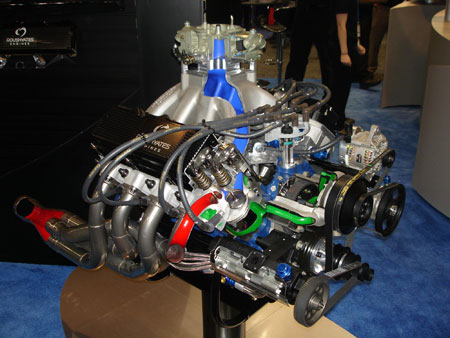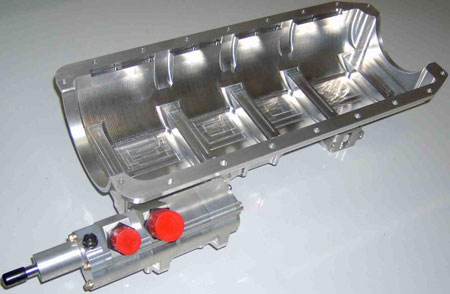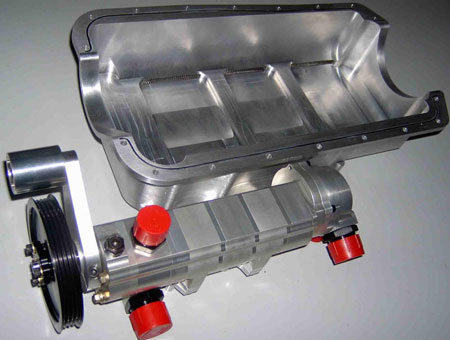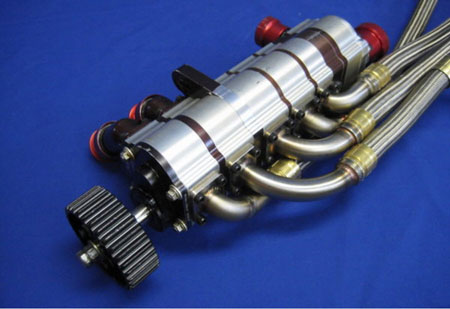Dry sump oil systems are used on all kinds of racing applications from NASCAR, circle track, road course and Formula One racing to ProStock drag racing. Dry sump oil systems are even found in some current production applications such as the LS9, LS7 and LS3 engines in late model Corvette ZR1, ZO6 and Grand Sport models.
One of the main reasons why dry sump oil systems are used in these applications is to reduce the risk of oil starvation or aeration. When a race car is cornering hard or accelerating at full throttle, G-forces can push the oil inside a conventional oil pan away from the oil pickup tube. Baffles and a deeper oil pan can reduce the risk of oil starvation, but not entirely. By eliminating the oil pickup inside the oil pan entirely, a constant supply of oil can be fed to the engine by an external belt, gear or cam driven oil pump. That means a steady oil supply and consistent oil pressure under any kind of driving conditions.
Power Advantages
Another reason for using a dry sump oil system is to reduce windage, oil splash and drag inside the crankcase. A well-designed windage tray inside a wet sump oil pan can help keep oil away from the spinning crankshaft to reduce drag. But there’s still a LOT of oil sloshing and splashing around inside the engine, not to mention a LOT of air resistance, especially at higher engine rpms.
A dry sump oil system uses a scavenge or suction pump to pull air and oil out of the oil pan. This keeps oil away from the crankshaft to reduce oil drag, and also pulls out most of the air to reduce windage and air drag (if the dry sump system has enough suction to produce vacuum in the crankcase).
Depending on the application, the resulting reduction in internal crankcase windage and drag may increase the engine’s power output 5 to 15 hp or more. But to realize these gains, the dry sump oil system has to pull at least 8 to 10 inches Hg or more of vacuum. Higher levels of vacuum (say 18 to 20 inches Hg) can yield more power gains, but typically only at very high engine speeds (above 8,000 rpm).
Otherwise, increasing crankcase vacuum with more and more suction incurs no extra power gains. And with a low rpm, long stroke, high torque motor, a dry sump oil system is probably not going to show any measurable power gain.
The ability to pull more crankcase vacuum requires more suction pumps, typically four, five or six. A two-stage or three-stage dry sump oil system with two or three scavenge pumps stacked together will usually not pull enough suction to create high vacuum inside the crankcase. But a four-stage, five-stage or six-stage dry sump oil system that is sucking air and oil out of the crankcase and lifter valley can generate high levels of vacuum, even at high engine speeds and loads when blowby increases.
The hot setup these days is a six-stage system that uses one suction pump to pull air and oil out from under each pair of cylinders on a V8, plus two more pumps to suck vapors out of both ends of the lifter valley under the intake manifold.
Because there is less oil splashing around inside the crankcase, further power gains may be possible by optimizing the engine for a dry sump oil system. This includes using lower tension oil rings to reduce friction. The lower the tension of the ring pack, the less the friction against the cylinder walls as the pistons move up and down. Reducing ring tension with thinner, narrower rings may free up an additional 20 to 40 horsepower.
Vacuum Checks
If you’re building an engine for a high vacuum dry sump oil system, you have to make sure the engine is sealed up tightly so that outside air isn’t pulled into the crankcase, lifter valley and valve covers when the engine is running. Special crankcase end seals with reversed lips may be required to hold vacuum inside the crankcase.
You obviously can’t run open valve cover breathers because the suction pumps will pull air in through the breathers. All the gaskets likewise have to be robust enough, stiff enough and sealed properly so they don’t leak air when the dry sump oil system is pulling vacuum inside the engine.
You should test the integrity of the gaskets by pressure testing the engine once it has been assembled. This can be done using shop air and an adjustable pressure regulator. Block off the oil pan suction outlets and the oil pressure inlet fittings, then connect the air supply line to one of the oil pan outlet ports. Slowly increase air pressure into the engine until it reaches about 8 psi, then listen for any hissing sounds that would indicate air leakage.
You can also spray soapy water along the valve cover, oil pan and intake manifold gasket seams to watch for bubbles. There should be none if the engine is sealed tight. If you’re using RTV silicone in lieu of a conventional pan or cover gasket, make sure the silicone has fully cured before subjecting it to pressure or vacuum.
Another method of checking for air leaks would be to pull vacuum in the crankcase by attaching an A/C vacuum pump to one of the oil pan outlet ports. Pull vacuum on the engine, then stop to see if the vacuum level holds steady for several minutes. If you can’t pull much vacuum or the vacuum level rapidly drops once the pump has been turned off, there’s a leak somewhere that needs to be found and sealed.
Lowers Center of Gravity and Oil Temperature
Another reason why many race cars are fitted with a dry sump oil system is because it allows the use of a shallower low profile oil pan. This, in turn allows the engine to be mounted lower in the chassis for a lower center of gravity, better handling and a lower hood profile. If ground clearance is an issue, a shallow oil pan can fix that problem, too.
Because a dry sump oil system stores oil in an external tank rather than the oil pan, the amount of oil in the reservoir can be increased to reduce the risk of oil starvation at high rpm. The external tank also helps reduce oil operating temperatures when the engine is running at high rpm or load for long periods of time. An external oil cooler can be plumbed in series with the storage tank to provide additional cooling as needed.
A dry sump external oil tank may hold as much oil as required depending on the application and the engine’s requirements (typically one to six gallons). When oil enters the tank, it hits a splitter then spreads out and flows across a baffle to separate oil and air bubbles. The oil then drains to the bottom of the tank where it is pulled back to the engine by the pressure pump.
One of the keys to setting up a dry sump oil system is figuring out how much oil the engine actually needs. Pushing too much oil volume through the engine just wastes horsepower to drive the oil pump. This is where an oil flow meter comes in handy. By using a flow meter in the oil supply line, the engine’s actual oil needs can be determined by measuring flow in gallons per minute.
The oil pump can then be sized accordingly to provide just the right amount of oil without wasting additional horsepower for oil that isn’t needed. Oil flow requirements will depend on oil viscosity, bearing clearances and whether or not piston oilers or valvetrain oilers are used (the latter can increase the need for extra oil flow significantly).
The Disadvantages of Dry Sump Oil Systems
If dry sump oil systems have so many advantages, why aren’t they used on all performance engines? Cost is the main stumbling block. Depending on the number and type of pumps used, the design of the oil pan, the size of the oil storage tank and oil cooler, and the complexity of the plumbing, a typical dry sump oiling system can cost up to $3,000 or more. Many pumps sell for $650 to $1,500 or more, and some can be very pricey if they are a custom made CNC billet pump.
Consequently, the cost of a sophisticated dry sump oil system would be hard to justify for a Saturday night budget racer or a typical street performance car. But where reliability is an absolute must (as in NASCAR, Formula One and other high end racing venues), a dry sump oil system may be the only way to go.
Dry sump oil pumps use a variety of designs, including roots-style four lobe rotors, three-lobe rotors, gerotors and spur gears. Various tooth profile and pump housing enhancements are used to maximize pump efficiency and reduce pumping losses and cavitation. Clearances must be kept very tight inside the pump for maximum flow. The type of materials used to make the pump housing and gears will also affect its durability and price.
Because the pumps are mounted externally, they are typically belt driven with a toothed or cogged rubber belt (similar to a pint-sized timing belt). The teeth on the belt prevent the pump drive from slipping. Most oil pumps are driven at about half crankshaft speed, ranging from 57 to 45 percent of crank speed. The slower the pump can be turned to produce a given rate of flow, the more efficiently it operates and the less horsepower it consumes.
The risk with an external belt-driven pump is that a belt failure could cause a loss of lubrication resulting in engine failure. It happens occasionally, but most belt drives are extremely reliable. Cam driven oil pumps are also available that allow the pump to be mounted on the front of the engine.
With any type of external mounting system, though, the supporting brackets and fasteners must be reliable and capable of withstanding shaking and vibrations that could cause they to loosen or fail. The last thing you want to happen is for the oil pump to fall off in the middle of a race!
External oiling systems also require mounting the oil tank somewhere, and installing all the plumbing that’s required to connect the oil pan and engine scavenge ports to the suction pumps and oil tank. Additional lines are needed for an oil cooler and oil filter. Lots of hoses and fittings increase the risk of oil leaks, so hoses must be strong and reinforced (braided stainless steel is usually recommended although rubber hoses can be used).
Suction hoses must be capable of withstanding vacuum without collapsing, and pressure supply hoses from the pressure pump to the oil filter, oil cooler and engine must be capable of withstanding high oil pressure (up to 80 psi or higher ) without bursting. Blowing a hose could starve the engine for oil. Hoses must also be supported so they don’t chafe or rub against anything, and kept away or shielded from hot exhaust headers.
Some question the trade-off between the extra power required to turn a stack of scavenge pumps and the horsepower gained by pulling air and oil out of the crankcase. The amount of power needed to drive the pressure pump is essentially the same whether an engine has a wet or dry sump oil pump, or whether the oil pump is mounted inside the engine or outside the engine.
In both cases, it takes the same amount of horsepower to move the same volume of oil. Some pumps are more efficient than others and require less horsepower to operate. But given similar gear designs, power requirements are about the same whether the pump is inside or outside the engine.
The extra power required to drive the scavenge pumps depends on the number of stages obviously (more pumps require more power), but the power required is less than that of a pressure pump because the pump is pulling out air and oil under vacuum rather than forcing liquid oil against the resistance created by the oil filter, oil galleries and tight bearing clearances inside the engine.
So depending on engine speed and the number and type of pumps, there may be a slight penalty for running a dry sump oil system (say five or more horsepower), or it may be a breakeven proposition, or a gain of maybe 5 to 15 horsepower or more.
The biggest gains come at high rpms when there’s less air inside the engine. Less air means the pistons don’t have to displace as much air with every down stroke and the crankshaft and rods can spin with less aerodynamic drag. That’s why jets fly at high altitude where the air is thinner. It creates less resistance so they can fly faster while using less fuel.
Another concern that may be an issue in some engines with dry sump oil systems is getting enough oil lubrication and cooling to the pistons and wrist pins. These parts rely on splash lubrication and cooling. If too much oil is pulled out of the crankcase too quickly there’s a chance the pistons might overheat and scuff, or that the wrist pins might fail.
The fix for these really high horsepower, high heat applications is to use of piston oilers that squirt oil directly at the underside of the pistons. The trade off here is that oils also increase the engine’s oil volume requirements, which requires more flow from the oil pump to maintain the same oil pressure.
As for flat tappet cam and lifter lubrication, or upper valvetrain lubrication, routing more oil to these components may be necessary to reduce the risk of lubrication-related failures if a dry sump oil system is used to pull air and oil vapor out of the lifter valley.
One other concern with dry sump oil systems is what happens when an engine blows and debris is sucked into the oil system. On the plus side, a dry sump system will suck the debris out of the oil pan so it isn’t pulled back into the oil pump and engine as might be the case with an internal oil pump and wet sump system.
The downside is that all of this debris ends up contaminating the oil storage tank, oil cooler and external oil plumbing. Thoroughly cleaning (or replacing) all of these components is absolutely essential to make sure no debris remains in the system to cause problems when the engine is replaced or rebuilt.
NASCAR Dry Sump Oil Systems
A NASCAR Cup race can be a grueling event, especially on a Super Speedway circuit where engine rpms and operating temperatures push the limit. To find out what kind of lubrication system can withstand this kind of punishment, we asked John Barilka of Hendrick Motorsports about the dry sump oil systems they use on their Cup motors.
“We use a 5-stage setup with four scavenge pumps evacuating air and oil from the oil pan and one pump scavenging the lifter valley area of the block. We’ve found that it takes about one atmosphere of vacuum in the crankcase to do a good job evacuating the air and oil. We use gear-style pumps because they do a good job pulling vacuum.”
Barilka says a good dry sump system is typically good for about a 25 horsepower gain, or about a three percent improvement in the engine’s power output. However, more vacuum in the crankcase is not necessarily better because you quickly reach a point of diminishing returns where additional vacuum does not generate a significant increase in power.
“A dry sump oil system will always reduce friction and drag. All the NASCAR teams use them, and the setups will vary somewhat. On our engines, we use a belt driven pump that routes oil to a 4-1/2 gallon storage tank. We also use an oil cooler, and the plumbing is Brown & Miller lightweight stainless braided lines.”
Barilka said the dry sump oil system allows them to use lower tension piston rings to reduce internal engine friction, but it also requires the use of piston oilers because there is so much less oil flinging around inside the crankcase to cool the pistons.


















